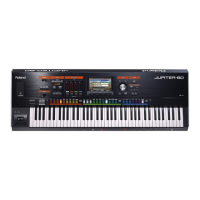47
Introduction Playing Sounds Editing Sounds
Other Convenient
Functions
Connecting Other
Equipment
Appendix
Moving Your Hand to Modify the
Pitch or Volume (D Beam Controller)
You use the D Beam controller simply by moving your hand above
it. By assigning dierent functions to it, you can control the sound
in various ways.
MEMO
D Beam controller settings are saved in the Registration.
1. Press the D BEAM [PITCH], [VOLUME], or [ASSIGNABLE]
button to turn the D Beam controller on.
Button Explanation
[PITCH] button
The pitch will change as you move your hand
above the D Beam controller.
[VOLUME] button
The volume will change, allowing you to add
expression to your performance.
[ASSIGNABLE] button
The function assigned to the D Beam
controller will be controlled.
MEMO
You can assign a performance-related function to the
[ASSIGNABLE] button. The function assigned to the
[ASSIGNABLE] button is specied by the Registration Common/
Control parameter D Beam (p. 31).
2. While playing the keyboard to produce sound, position
your hand above the D Beam controller and slowly move
it up and down.
3. To turn o the D Beam controller, once again press the
button you pressed in step 1 (the button will go out).
Eective range of the D Beam controller
This illustration shows the eective range of the
D Beam controller. No eect will be obtained
if you position your hand outside the eective
range.
NOTE
The eective range of the D Beam controller
will change depending on the lighting
conditions. If the D Beam controller does not
work as you expect, readjust the sensitivity.
For details on readjust the sensitivity, refer to “D Beam Sens” (p.
84).
Changing the Pitch/Applying Vibrato
(Pitch Bend/Modulation Lever)
While playing the keyboard, move the lever toward the left to lower
the pitch, or toward the right to raise the pitch. This is called “pitch
bend.”
Moving the lever away from yourself will apply vibrato.
This is called “modulation.”
Moving the lever away from yourself while also moving it to left or
right will apply both eects simultaneously.
MEMO
For some sounds, the modulation lever will produce a dynamics
eect.
Using the Buttons and Knobs to Modify the
Sound ([S1] [S2] buttons / [E1]–[E4] knobs)
Performance-related functions are assigned to the [S1] [S2] buttons
and [E1]–[E4] knobs. While you perform, you can operate the [S1]
[S2] buttons or [E1]–[E4] knobs to modify the sound in real time.
Turning the [S1] [S2] buttons on/o will turn on/o or switch the
assigned function.
MEMO
You can assign performance-related functions to the [S1] [S2]
buttons. The [S1] [S2] button assignments are specied by the
Registration Common/Control parameters S1-S2 (p. 31).
If the [E1]–[E4] knobs are shown in the Lower Part of the display,
operating these knobs will control the functions assigned to them.
Controlling the Performance

